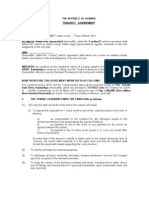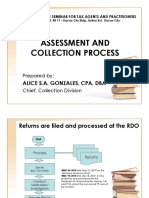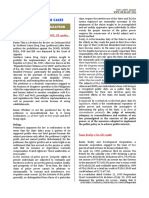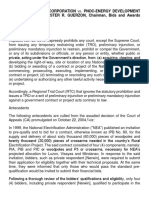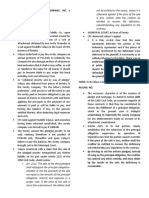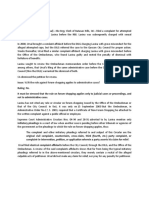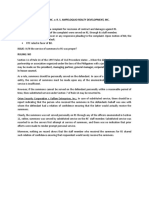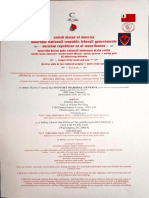Villarica Pawnshop V Sps Gernale
Villarica Pawnshop V Sps Gernale
Uploaded by
Stella LynCopyright:
Available Formats
Villarica Pawnshop V Sps Gernale
Villarica Pawnshop V Sps Gernale
Uploaded by
Stella LynOriginal Description:
Original Title
Copyright
Available Formats
Share this document
Did you find this document useful?
Is this content inappropriate?
Copyright:
Available Formats
Villarica Pawnshop V Sps Gernale
Villarica Pawnshop V Sps Gernale
Uploaded by
Stella LynCopyright:
Available Formats
Villarica Pawnshop v Sps Gernale
FACTS
CASE1: Sps Gernale filed a complaint for Quieting of Title and Damages against Villarica before
the RTC.
CASE2: Villarica [and the previous owners of the parcels of land] filed for annulment and
cancellation of titles and damages against the Gernales. And since the lots were mortgaged by
the Gernales in 1998, they also impleaded BPI.
Gernales filed a motion to dismiss CASE2 arguing among others that elements of litis pendentia
were present.
RTC denied the motion.
ISSUES: W/N there was litis pendentia? If there is, which of the cases should be dismissed?
RULING: There was litis pendentia
Identity of parties, or at least such as representing the same interests in both actions
What is primordial is that the primary litigants in the first case are also parties to the second
action.
Villarica and Sps Gernale are parties to both cases
Identity of rights asserted and relief prayed for, the relief being founded on the same facts; and the
identity of the two cases such that judgment in one, regardless of which party is successful, would
amount to res judicata in the other.
The test to determine whether the causes of action are identical is to ascertain whether the
same evidence will sustain both actions, or whether there is an identity in the facts essential to
the maintenance of the two actions.
CASE1 and CASE 2 are different only in the form of action, but an examination of the allegations
in both cases reveals that the main issue raised, which is ownership of the land, and the principal
relief sought, which is cancellation of the opposing parties' transfer certificates of title, are
substantially the same. The evidence required to substantiate the parties' claims is likewise the
same.
***
There is no hard and fast rule in determining which actions should be abated on the ground of litis
pendentia. However, the Supreme Court has set the relevant factors that lower courts must consider
when they have to determine which case should be dismissed, given the pendency of two actions. These
are:
(1) the date of filing, with preference generally given to the first action filed to be retained;
(2) whether the action sought to be dismissed was filed merely to preempt the latter action or to
anticipate its filing and lay the basis for its dismissal; and
(3) whether the action is the appropriate vehicle for litigating the issues between the parties.
In the instant case, it would therefore be more in keeping with the demands of law and equity if the two
cases, which involve the same parties and affecting closely related subject matters, be consolidated.
You might also like
- Tenancy AgreementDocument4 pagesTenancy AgreementMichael Nkanika78% (36)
- Property Law ChartsDocument10 pagesProperty Law ChartsWilliam Stroud100% (6)
- Vela - Secured Transactions OutlineDocument90 pagesVela - Secured Transactions OutlineJonathan Vela100% (8)
- NDA Final TemplateDocument6 pagesNDA Final TemplateMayverii100% (1)
- Conveyancing Law in Kenya 2014Document159 pagesConveyancing Law in Kenya 2014Hezzy Okello100% (6)
- Facts of Stack V DowdenDocument4 pagesFacts of Stack V DowdenReal TrekstarNo ratings yet
- SORIANO Vs MANUZONDocument3 pagesSORIANO Vs MANUZONStella LynNo ratings yet
- NAPOCOR v. Heirs of SangkayDocument2 pagesNAPOCOR v. Heirs of SangkayRusselLubangco100% (2)
- Northern Pacific R. Co. v. Babcock, 154 U.S. 190 (1894)Document10 pagesNorthern Pacific R. Co. v. Babcock, 154 U.S. 190 (1894)Scribd Government DocsNo ratings yet
- Serology RequestDocument6 pagesSerology RequestJeffrey NocedaNo ratings yet
- Given To Messrs. Kuenzle and Streiff."Document2 pagesGiven To Messrs. Kuenzle and Streiff."Mickey RodentNo ratings yet
- 7 Paje v. Casino (Tables)Document5 pages7 Paje v. Casino (Tables)Reena Alekssandra AcopNo ratings yet
- Opic in Yllabus: Athena de Mesa Page 1 of 2 Case # 10Document2 pagesOpic in Yllabus: Athena de Mesa Page 1 of 2 Case # 10Joshua AbadNo ratings yet
- Taxation 1 Midterm 2022Document6 pagesTaxation 1 Midterm 2022Jawaher MacalangcomNo ratings yet
- Caneda CADocument4 pagesCaneda CAFebbieKatreennNo ratings yet
- PNB Vs Manila OilDocument1 pagePNB Vs Manila OiljeninaaningNo ratings yet
- Burden of Proof Vs Burden of EvidenceDocument4 pagesBurden of Proof Vs Burden of Evidenceazalea marie maquiranNo ratings yet
- Torres Vs LopezDocument2 pagesTorres Vs LopezVernon Arquines0% (1)
- Spouses Lambino Versus HonDocument1 pageSpouses Lambino Versus HonJessaMangadlaoNo ratings yet
- Estate of The Late Juliana Diez Vda. de Gabriel vs. CommissionerDocument15 pagesEstate of The Late Juliana Diez Vda. de Gabriel vs. Commissionerangelsu04No ratings yet
- CIR v. General FoodsDocument3 pagesCIR v. General FoodsShiella RealNo ratings yet
- Security and Credit Transactions: Contract of DepositDocument64 pagesSecurity and Credit Transactions: Contract of DepositH100% (1)
- 7 Tabasondra v. Spouses ConstantinoDocument2 pages7 Tabasondra v. Spouses Constantinot7uyuytuNo ratings yet
- Camposagrado V Camposagrado - 469 SCRA 602, September 13, 2005Document6 pagesCamposagrado V Camposagrado - 469 SCRA 602, September 13, 2005jdz1988No ratings yet
- Alexandra v. LLDA - CaseDocument5 pagesAlexandra v. LLDA - CaseRobeh AtudNo ratings yet
- Ramos Vs PeraltaDocument5 pagesRamos Vs PeraltaKarla Marie TumulakNo ratings yet
- People V InvencionDocument7 pagesPeople V InvencionTicia Co SoNo ratings yet
- Evid Case Digest - Onarosa-Palmones-Lariosa (By Ople)Document2 pagesEvid Case Digest - Onarosa-Palmones-Lariosa (By Ople)fikfakvoomvoomvoomNo ratings yet
- 06 Pantaleon V American Express DigestDocument3 pages06 Pantaleon V American Express DigestjoyeduardoNo ratings yet
- Nacar VS NistalDocument5 pagesNacar VS NistalChiefJusticeLaMzNo ratings yet
- Taxation II DigestsDocument365 pagesTaxation II DigeststakyousNo ratings yet
- Civpro ReportDocument20 pagesCivpro ReportEdwin VillaNo ratings yet
- G.R. No. 108538. January 22, 1996: Petitioners, V. The Honorable Court of AppealsDocument2 pagesG.R. No. 108538. January 22, 1996: Petitioners, V. The Honorable Court of AppealsArmen MagbitangNo ratings yet
- Spouses Lim Vs Limg.r. No. 163209Document1 pageSpouses Lim Vs Limg.r. No. 163209Levi IsalosNo ratings yet
- Prima Paint Corp. v. Flood & Conklin Mfg. Co., 388 U.S. 395 (1967)Document22 pagesPrima Paint Corp. v. Flood & Conklin Mfg. Co., 388 U.S. 395 (1967)Scribd Government DocsNo ratings yet
- BarOps 3rd SetDocument30 pagesBarOps 3rd SetVeah CaabayNo ratings yet
- Intosai Gov 9130 eDocument39 pagesIntosai Gov 9130 enmsusarla999No ratings yet
- G.R. No. L-12790Document2 pagesG.R. No. L-12790David Jayson Barcelona OquendoNo ratings yet
- Banking Midterms AUF SOLDocument29 pagesBanking Midterms AUF SOLGodofredo SabadoNo ratings yet
- Property Tac-An Dano Vs IacDocument2 pagesProperty Tac-An Dano Vs IacPafra BariuanNo ratings yet
- Villanueva Vs DomingoDocument1 pageVillanueva Vs DomingoNath AntonioNo ratings yet
- CT4. Garcia v. ThioDocument2 pagesCT4. Garcia v. ThioJaypoll DiazNo ratings yet
- Case 1: Hu Niu V Collector of Customs FactsDocument10 pagesCase 1: Hu Niu V Collector of Customs FactsSei KawamotoNo ratings yet
- La Mallorca v. CADocument1 pageLa Mallorca v. CAecsventuraNo ratings yet
- Form 1 Retainer RecordDocument29 pagesForm 1 Retainer RecordGian Tristan Madrid100% (1)
- Bagumbayan-Vnp Movement, Inc. vs. ComelecDocument6 pagesBagumbayan-Vnp Movement, Inc. vs. ComelecRaeNo ratings yet
- Barretto Realty Dev Vs CADocument3 pagesBarretto Realty Dev Vs CAHazel BarbaronaNo ratings yet
- Sarkies Tours Phils. VS IacDocument2 pagesSarkies Tours Phils. VS Iac001nooneNo ratings yet
- Cariaga Vs LagunaDocument2 pagesCariaga Vs LagunaMaCai YambaoNo ratings yet
- Saludo Jr. vs. AMEXDocument2 pagesSaludo Jr. vs. AMEXAthena AthenaNo ratings yet
- De Leon vs. CA 278 Scra 94Document7 pagesDe Leon vs. CA 278 Scra 94Ram PagongNo ratings yet
- Comprehensive Seminar - Assessmentcollection ProcessDocument37 pagesComprehensive Seminar - Assessmentcollection ProcessMarco Fernando Lumanlan NgNo ratings yet
- Ocho v. CalosDocument2 pagesOcho v. CalosMaya Julieta Catacutan-EstabilloNo ratings yet
- Hornilla Vs Salunat - AC 5804 - July 1, 2003 - JDocument4 pagesHornilla Vs Salunat - AC 5804 - July 1, 2003 - Jcarlota ann lafuenteNo ratings yet
- Chipongian v. Benitez-LirioDocument10 pagesChipongian v. Benitez-LirioVictoria EscobalNo ratings yet
- Cañete Et Al. vs. Genuino Ice Company, IncDocument1 pageCañete Et Al. vs. Genuino Ice Company, IncRean Raphaelle GonzalesNo ratings yet
- Ombudsman Vs DechavezDocument14 pagesOmbudsman Vs DechavezJess RañaNo ratings yet
- 15 Domingo Vs GarlitosDocument1 page15 Domingo Vs GarlitosJorela TipanNo ratings yet
- Metro Inc v. CIRDocument2 pagesMetro Inc v. CIRJahn Avery Mitchel DatukonNo ratings yet
- de Pedro Vs RomasanDocument8 pagesde Pedro Vs RomasanGladys BantilanNo ratings yet
- Concurrence and PreferenceDocument4 pagesConcurrence and PreferenceMary Jane Climaco GamoseNo ratings yet
- PRIL Querubin Vs QuerubinDocument3 pagesPRIL Querubin Vs QuerubinAlfonso Vargas100% (1)
- FAR EAST INTERNATIONAL IMPORT and EXPORT CORPORATION, CO., LTD., ET AL., NANKAI KOGYO CO., LTDDocument2 pagesFAR EAST INTERNATIONAL IMPORT and EXPORT CORPORATION, CO., LTD., ET AL., NANKAI KOGYO CO., LTDKristine Hipolito SerranoNo ratings yet
- 56 International Container V Prudential GuaranteeDocument5 pages56 International Container V Prudential GuaranteeMae MaihtNo ratings yet
- Final Exam Question No. 1Document7 pagesFinal Exam Question No. 1Ianna Carmel QuitayenNo ratings yet
- Kalaw V Fernandez DigestDocument20 pagesKalaw V Fernandez DigestMonica SalvadorNo ratings yet
- Taxation I Midterm Cases PDFDocument28 pagesTaxation I Midterm Cases PDFLaurence ObaobNo ratings yet
- Umale Vs Canoga Park Case DigestDocument2 pagesUmale Vs Canoga Park Case DigestShiela Marie GonzalesNo ratings yet
- Ra 9255, 10172Document2 pagesRa 9255, 10172Stella LynNo ratings yet
- Nerwin V PNOC - Full TextDocument12 pagesNerwin V PNOC - Full TextStella LynNo ratings yet
- LIM TAY Vs CADocument2 pagesLIM TAY Vs CAStella Lyn100% (1)
- Am No 03-04-04-SC Custody of Minors and WHCDocument7 pagesAm No 03-04-04-SC Custody of Minors and WHCStella LynNo ratings yet
- A Domestic Solution For Transboundary Harm - Singapores Haze Poll by Mahdev MohanDocument10 pagesA Domestic Solution For Transboundary Harm - Singapores Haze Poll by Mahdev MohanStella LynNo ratings yet
- Vs. Honorable Court of Appeals, Province: Nego Midterm (Forgery) 1Document54 pagesVs. Honorable Court of Appeals, Province: Nego Midterm (Forgery) 1Stella LynNo ratings yet
- Manila Surety and Fidelity Company V VelayoDocument1 pageManila Surety and Fidelity Company V VelayoStella LynNo ratings yet
- Compania Agricola V NepomucenoDocument6 pagesCompania Agricola V NepomucenoStella LynNo ratings yet
- Dabalos V RTC (Full Text)Document4 pagesDabalos V RTC (Full Text)Stella LynNo ratings yet
- Sexual Harrassment CasesDocument16 pagesSexual Harrassment CasesStella Lyn0% (1)
- Brush Pen Exercise SheetsDocument28 pagesBrush Pen Exercise SheetsStella Lyn100% (1)
- Code of Professional ResponsibilityDocument5 pagesCode of Professional ResponsibilityStella LynNo ratings yet
- Legal Ethics/ PALE CasesDocument19 pagesLegal Ethics/ PALE CasesStella LynNo ratings yet
- Code of Judicial ConductDocument3 pagesCode of Judicial ConductStella LynNo ratings yet
- Benguet Corp V CBAA PDFDocument8 pagesBenguet Corp V CBAA PDFStella LynNo ratings yet
- Crisostomo V CADocument2 pagesCrisostomo V CAStella LynNo ratings yet
- Caselist 1 - FinalsDocument60 pagesCaselist 1 - FinalsStella LynNo ratings yet
- Mercader V DBPDocument2 pagesMercader V DBPStella LynNo ratings yet
- Patricio V LevisteDocument1 pagePatricio V LevisteStella LynNo ratings yet
- Sarkies Tours V CADocument2 pagesSarkies Tours V CAStella LynNo ratings yet
- Taruc V CADocument1 pageTaruc V CAStella LynNo ratings yet
- Robern V QuitainDocument1 pageRobern V QuitainStella LynNo ratings yet
- San Miguel Corporation V MonasterioDocument1 pageSan Miguel Corporation V MonasterioStella LynNo ratings yet
- Tomawis V TabaoDocument1 pageTomawis V TabaoStella LynNo ratings yet
- Collado V BravoDocument1 pageCollado V BravoStella Lyn100% (1)
- Benavidez V SalvadorDocument1 pageBenavidez V SalvadorStella LynNo ratings yet
- Laxina V OmbudsmanDocument1 pageLaxina V OmbudsmanStella LynNo ratings yet
- BD Longspan V RS AmpeloquioDocument1 pageBD Longspan V RS AmpeloquioStella LynNo ratings yet
- Abaigar V AbaigarDocument1 pageAbaigar V AbaigarStella LynNo ratings yet
- Kolin Electronics Co., Inc. v. Kolin Phils. International, Inc., G.R. No. 228165, Feb. 9, 202Document28 pagesKolin Electronics Co., Inc. v. Kolin Phils. International, Inc., G.R. No. 228165, Feb. 9, 202Christopher ArellanoNo ratings yet
- 1441+1+21 Lien Provost MarshalDocument7 pages1441+1+21 Lien Provost Marshalmusa jew beyNo ratings yet
- Code of Civil Procedure & Limitation ActDocument25 pagesCode of Civil Procedure & Limitation ActHarshvardhan MelantaNo ratings yet
- Mision 1 Punto 1Document8 pagesMision 1 Punto 1estudio eficienteNo ratings yet
- DEED OF DONATION - Mun. of Gloria & Bureau of FireDocument2 pagesDEED OF DONATION - Mun. of Gloria & Bureau of FireVic Ruskin OngNo ratings yet
- Rural Bank of Sariaya Vs YaconDocument2 pagesRural Bank of Sariaya Vs YaconGillian Caye Geniza BrionesNo ratings yet
- DIS Mutual NDA - Vietnam - 06-2021 - Trinam Vietnam AFIS FilledDocument4 pagesDIS Mutual NDA - Vietnam - 06-2021 - Trinam Vietnam AFIS Filleddqt0410No ratings yet
- Eliza Fraser KitabıDocument28 pagesEliza Fraser KitabıBurcuNo ratings yet
- Bar Questions 1997-2013Document8 pagesBar Questions 1997-2013JOBELLE DIWANo ratings yet
- Barbri CivPro OutlineDocument101 pagesBarbri CivPro Outlineseddit100% (5)
- AGREEMENT-Puja DasDocument9 pagesAGREEMENT-Puja Dasanisha sarkarNo ratings yet
- Equity and Trust 2 - Tutorial 3Document2 pagesEquity and Trust 2 - Tutorial 3Yuvanesh KumarNo ratings yet
- User Manual - Barcode Label PrintingDocument5 pagesUser Manual - Barcode Label PrintingSwetha nairNo ratings yet
- Blackberry-Typo Ruling, Aug 21Document9 pagesBlackberry-Typo Ruling, Aug 21jeff_roberts881No ratings yet
- Soriano v. Bravo PDFDocument16 pagesSoriano v. Bravo PDFAshley Kate PatalinjugNo ratings yet
- API 572 2001 Inspection of Pressure Vessels PDFDocument80 pagesAPI 572 2001 Inspection of Pressure Vessels PDFMohamed FazilNo ratings yet
- Copyright NoticeDocument1 pageCopyright NoticeAmbassador: Basadar: Qadar-Shar™, D.D. (h.c.) aka Kevin Carlton George™No ratings yet
- Bill No. 28 of 2022 APDocument87 pagesBill No. 28 of 2022 APpearkuNo ratings yet
- Intellectural Property Assignment 2Document8 pagesIntellectural Property Assignment 2Mike MwaleNo ratings yet
- Quieting PropertyDocument12 pagesQuieting PropertyAchilles Neil EbronNo ratings yet
- !court: L/,epubhr of Tbe !lbilippines FfianilaDocument13 pages!court: L/,epubhr of Tbe !lbilippines FfianilaThe Supreme Court Public Information OfficeNo ratings yet
- Deed of Sale of Registered LandDocument3 pagesDeed of Sale of Registered LandHannief Ampa21No ratings yet
- NAAWAN COMMUNITY RURAL BANK vs. CADocument2 pagesNAAWAN COMMUNITY RURAL BANK vs. CAmark anthony mansuetoNo ratings yet
